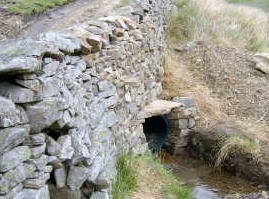 The demands on moorland drains and water courses changes from season to season. What appears as a dry gulley in summer can be a raging torrent in winter. Planning work for water course alterations must be done in winter, in order to fully appreciate the requirements. This is particularly important near and crossing access tracks and paths – getting the design wrong can result in sections being washed away.
The demands on moorland drains and water courses changes from season to season. What appears as a dry gulley in summer can be a raging torrent in winter. Planning work for water course alterations must be done in winter, in order to fully appreciate the requirements. This is particularly important near and crossing access tracks and paths – getting the design wrong can result in sections being washed away.
Surface drains
These can be dug to keep water flow away from tracks, therefore preventing water erosion of the track surface. Where a water course has to cross a track a ford or a culvert can be created. The choice is largely dictated by the ground and what has been there before.
Fords
Fords can be subjected to considerable wear and tear from traffic, surface water and by frost. DMS favours the use of stone cast fords laid in a foundation of concrete, which ensures that the stone is secure and that the ford surface won’t break. Earth is pushed into the stone gaps to ensure that the concrete is hidden and that vegetation can root.
Culverts
Where a culvert is to carry water under the track surface, attention to detail ensures that the entry and exit to the culvert are properly built with local stone.
Surface water
Sometimes the geography of the track or path dictates that there is no option but to allow water to run down the track surface. Where this is the case the choice of track construction is crucial and can make the difference between the surface lasting just a year or 50.






